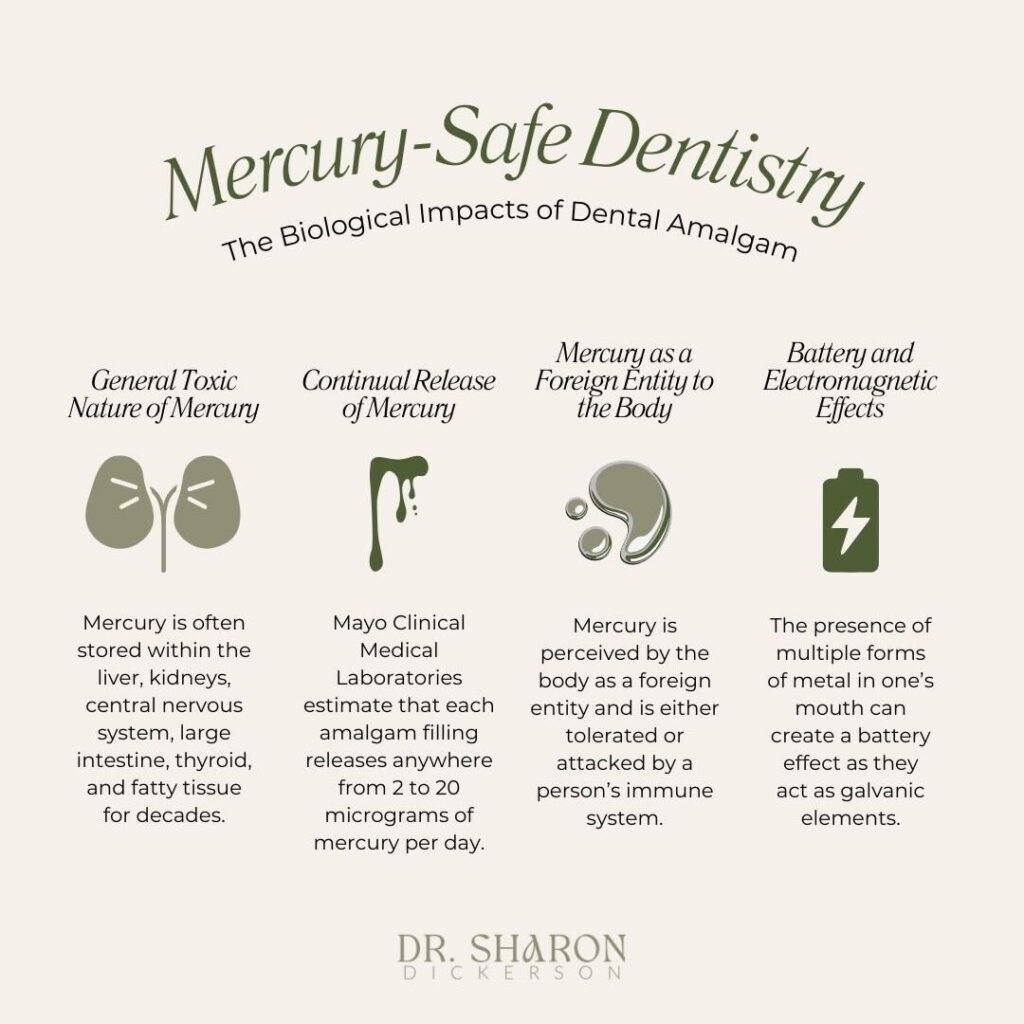What is Mercury?
Mercury-safe dentistry relates to the chemical element, Mercury (Hg). This is a heavy metal that naturally occurs within the Earth’s crust. It can take three forms: elemental, inorganic, and organic.1 Within the natural world, mercury is generally not found in a liquid form.
Mercury in Dentistry
When discussing mercury within the dental industry, it is most commonly referred to as amalgam. Dental amalgam is a liquid metal alloy mixture, the largest component of which is mercury (50% elemental mercury by weight).[2-4] Dental amalgam is also commonly referred to as a silver filling, metal filling, or mercury filling. It is often visibly detectable in the mouth based on its metallic display. However, even if the exterior of a crown or bridge presents as “white”, it is sometimes the case that mercury amalgam is encased underneath the restoration. The potential impact to human health due to dental amalgam exposure has received immense global attention in the past 40 years. In fact, in 1994, Sweden became the first country to phase out dental amalgam.5 Since then, many other countries such as Norway, Bangladesh, the Czech Republic, Finland, Ireland, Nepal, and Slovakia have followed suit in phasing out use of dental amalgam.[6-8] Yet, as of 2012, 45% of all dental restorations throughout the world still utilize amalgam.9
Your oral health is closely connected to your overall well-being, especially when it comes to dental treatments like mercury fillings, which can impact your body’s health over time. To explore how dental care can influence your holistic health journey, check out this informative article from Marion Dental about managing cracked and weak teeth due to mercury fillings.
The Biological Impacts of Dental Amalgam

- General Toxic Nature of Mercury: Mercury at unnaturally occurring levels can be highly toxic. The human body has difficulty destroying or detoxifying mercury. In fact, mercury is often stored within the liver, kidneys, central nervous system, large intestine, thyroid, and fatty tissue for decades.10 In the human brain, mercury has a half-life of 16-30 years.3 Although mercury exposure has many sources in present day, dental amalgams remain a significant source of exposure and accumulation.11
- Continual Release of Mercury: It is believed that dental amalgam fillings are continually releasing mercury when chewing, drinking, grinding, and brushing.[12, 13] Mayo Clinical Medical Laboratories estimate that each amalgam filling releases anywhere from 2 to 20 micrograms of mercury per day.14 While this may seem like a relatively small amount, the cumulative effect over the 10-20 year lifetime of a dental amalgam can result in low-dose mercury poisoning.10
- Mercury as a Foreign Entity to the Body: The mercury (as well as all other dental metal alloys) present in dental amalgam are not elements that naturally occur in the human body.10 Therefore, mercury is perceived by the body as a foreign entity and is either tolerated or attacked by a person’s immune system.15
- Battery and Electromagnetic Effects: The presence of multiple forms of metal in one’s mouth can create a battery effect as they act as galvanic elements. This process intensifies the corrosion of the metals, increasing the negative effects.[16, 17] There is also increasing research supporting the theory that electromagnetic fields are absorbed at significantly higher rates in those who have metals in their body.18 For example, someone using a cellphone who has metal in their mouth absorbs electromagnetic fields at 400-700 times higher than someone without metal.19
Symptoms Related to Amalgam Poisoning
Not all patients experience symptomatic presentation of mercury toxicity. However, that is not necessarily indicative of the overall toxic exposure, especially since the effects of amalgam poisoning are cumulative. For patients who do present symptomatically, negative effects can include: localized inflammation, chronic fatigue, limb pain, headaches, lack of concentration, memory loss, insomnia, unexplained palpitations, tinnitus, and hearing loss. [20, 21]
How to Remove/Treat Dental Amalgam
A growing number of dentists are now recognizing the need to not only cease administering dental amalgam, but also help patients by removing it safely. Due to the potential health risks if not extracted properly, it is recommended that you seek an IAOMT certified dentist who will perform mercury-safe removal with serious precautions (SMART protocols) implemented to minimize exposure. Mercury-safe removal protocols often include the following: amalgam separator to collect mercury waste, protective gowns for all persons in the treatment room, dental dam, saliva ejector placed under the dental dam, external air delivered to patient via nasal hood or nasal cannula, impermeable barrier over patients nose, high volume evacuation, copious amounts of water to reduce heat during amalgam removal, removal of the amalgam in the largest chunks possible, oral aerosol/air filtration vacuum system, ambient air filtration systems, pre and post rinse with metal binders such as charcoal or chlorella algae.22 Once the dental amalgam is safely removed, it can be replaced with more biocompatible materials such as composite or porcelain. It is also recommended that a patient garner additional support from a reputable holistic practitioner to ensure systemic support and proper detoxification while undergoing mercury-safe removal.
Dr. Sharon Dickerson DDS – Mercury-Safe
Dr. Sharon Dickerson DDS in Denver, Colorado considers mercury-safe dentistry to be a critical component in helping our patients achieve oral and whole-body vitality. Dr. Sharon Dickerson has been performing mercury-safe dentistry for over 20 years and continues to remain up-to-date on the latest research and protocols (both in the US and worldwide). In addition to implementing standard safety procedures, Dr. Sharon Dickerson DDS has taken extra measures to ensure that our newly renovated Denver office mitigates any vapor exposure quickly and effectively. Throughout the entire facility, no carpet or cloth curtains are used & a newly installed bi-polar ionization unit (the iWave-C commercial Air Cleaner system) ensures any residual particles are extracted immediately. Dr. Dickerson and then entire staff are dedicated to facilitating mercury-safe dentistry as one component of our comprehensive approach to biological dental care. To learn more about our process, please call us at 720.842.7002.
- United States Environmental Protection Agency, 2020. Basic Information About Mercury | US EPA. [online] US EPA. Available at: <https://www.epa.gov/mercury/basic-information-about-mercury> [Accessed 5 May 2020].
- Ferracane, Jack L. (2001). Materials in Dentistry: Principles and Applications – Jack L. Ferracane – Google Boeken. ISBN9780781727334. Retrieved 19 September 2012.
- Mutter J. Gesund statt chronisch krank!: Der ganzheitli- che Weg: Vorbeugung und Heilung sind möglich. 3rd ed. Weil der Stadt: Fit fürs Leben Verlag; 2014. 456 Seiten. (Gesundheit).
- Mutter J, Klinghardt D. Amalgam: Risiko für die Mensch- heit; Quecksilbervergiftungen richtig ausleiten, neue Fak- ten und Hilfe, auch nach der Amalgamentfernung! 3rd ed. Weil der Stadt: Fit-fürs-Leben-Verl. in der NaturaViva-Verl.- GmbH; 2013. 169 Seiten. (Gesundheit).
- UN Environment. Global Mercury Supply, Trade and Demand. Geneva, Switzerland: United Nations Environment Pro-gramme, Chemicals and Health Branch. 2017. Available from: http://wedocs.unep.org/bitstream/handle/20.500.11822/21725/global_mercury.pdf?sequence=1&isAllowed=y. Accessed April 2020.
- UN Environment. Global Mercury Supply, Trade and Demand. Geneva, Switzerland: United Nations Environment Pro-gramme, Chemicals and Health Branch. 2017. Available from: http://wedocs.unep.org/bitstream/handle/20.500.11822/21725/global_mercury.pdf?sequence=1&isAllowed=y. Accessed April 2020.
- Health Care without Harm. Four EU countries announce plans to phase out mercury fillings [press release]. August 28, 2019. Available from: https://noharm-europe.org/articles/news/europe/four-eu-countries-announce-plans-phase-out-mercury-fillings. Accessed October 2019. Comprehensive Review of Mercury in Dental Amalgam Fillings; www.iaomt.org; Page 14
- Government of Nepal Bans Use of Mercury Dental Amalgam and Mercury-Based Equipment. September 20, 2019. Available from: https://ipen.org/news/government-nepal-bans-use-mercury-dental-amalgam-and-mercury-based-equipment. Accessed April 2020..
- Heintze SD, Rousson V. Clinical effectiveness of direct Class II restorations—a meta-analysis. J Adhes Dent. 2012; 14(5):407-431.
- Swiss BioHealth, 2020. [online] Swiss-biohealth.com. Available at: <https://www.swiss-biohealth.com/wp-content/uploads/swiss-biohealth-concept-2019-en.pdf> [Accessed 5 May 2020].
- Mutter J. Is dental amalgam safe for humans? The opi- nion of the scientific committee of the European Commis- sion. Journal of occupational medicine and toxicology (London, England). 2011;62. doi:10.1186/1745-6673-6-2
- Taskinen H, Kinnunen E, Riihimäki V. A possible case of mercury-related toxicity resulting from the grinding of old amalgam restorations. Scandinavian Journal of Work, Envi- ronment & Health [Internet]. 1989;15(4):302–4. Available from: http://www.jstor.org/stable/40965672
- Eggleston DW, Nylander M. Correlation of dental amalgam with mercury in brain tissue. The Journal of Prosthetic Dentistry. 1987;58(6):704–7. doi:10.1016/0022- 3913(87)90424-0
- Mayo Clinic Laboratories, 2020. HG – Clinical: Mercury, Blood. [online] Mayocliniclabs.com. Available at: <https://www.mayocliniclabs.com/test-catalog/Clinical+and+Interpretive/8618> [Accessed 5 May 2020].
- McKee A, Fontenot A. Interplay of innate and adaptive immunity in metal-induced hypersensitivity. Current Opinion in Immunology. 2016;4225–30. doi:10.1016/j. coi.2016.05.001
- Zohdi H, Emami M, Reza H. Galvanic Corrosion Behavior of Dental Alloys. In: Valdez B, editor. EnvironmentalandIndustrial Corrosion – Practical and Theoretical Aspects: InTech; 2012.
- Saravanakumar P, Thallam Veeravalli P, Kumar V A, Mohamed K, Mani U, Grover M, Thirumalai Thangarajan S. Effect of Different Crown Materials on the InterLeukin-One Beta Content of Gingival Crevicular Fluid in Endodontically Treated Molars: An Original Research. Cureus. 2017;9(6):e1361. doi:10.7759/cureus.1361
- med. dent. Johann Lechner. Immunstress durch Zahnmetalle und Elektrosmog. Raum&Zeit;1995(74):5–13.
- Virtanen H, Huttunen J, Toropainen A, Lappalainen R. Interaction of mobile phones with superficial passivemetal- lic implants. Phys Med Biol. 2005;50(11):2689–700. doi:10.1088/0031-9155/50/11/017
- Lehmann I, Sack U, Lehmann J. Metal ions affecting the immune system. Met Ions Life Sci. 2011;8157–85.
- Klinghardt D. Neural Therapy & Mesotherapy Course A: The Intensive Klinghardt Academy;201180–2.
- IAOMT, 2020. The Safe Mercury Amalgam Removal Technique (SMART). [online] IAOMT. Available at: <https://iaomt.org/resources/safe-removal-amalgam-fillings/> [Accessed 5 May 2020].

